Synthesis of Poly(butylene succinate) Catalyzed by Tetrabutyl Titanate and Supported by Activated Carbon
Abstract
1. Introduction
2. Materials and Methods
2.1. Materials
2.2. Preparation of Catalysts
2.3. Synthesis of PBS
2.4. Purify
2.5. Catalyst Recycling
2.6. Characterization Methods
3. Results
3.1. Evaluation of Catalyst Activity
3.1.1. Effect of Catalyst Loading Rate on Catalytic Performance
3.1.2. Evaluation of Activity of Different Catalysts
3.2. Structural Characterization of Catalysts
3.2.1. The FT-IR Spectra
3.2.2. SEM
3.2.3. XRD
3.3. Optimization of Process Conditions for Catalytic Polymerization
3.3.1. Dehydration Temperature
3.3.2. Polycondensation Temperature
3.3.3. Acid–Alcohol Ratio
3.3.4. Catalyst Dosage
3.3.5. Esterification Time
3.3.6. Service Life of Catalyst
3.4. Structural Characterization of the Product
3.4.1. Infrared Spectrum of the Product
3.4.2. 1H NMR of the Product
4. Discussion
- The TBT catalyst was prepared using an impregnation method. After acid treatment, the oxygen-containing functional groups on the AC surface increased, providing more active sites for the supported TBT. The original ligands on the central Ti atom may partially exchange with ligands such as hydroxyl groups on the activated carbon, thus being activated to form active species, which shortens the time required for active species formation during the reaction. Therefore, this catalyst exhibits high activity.
- The experimental determination of the optimal process conditions for synthesizing PBS revealed that the ideal catalyst loading is 75%, the esterification temperature is 170 °C, the polycondensation temperature is 235 °C, with a molar ratio of succinic acid: 1,4-butanediol of 1:1.2, catalyst usage of 0.06 g, dehydration time of 3 h, and optimal catalyst amount of 0.3% of succinic acid mass. The resulting product has a number-average molecular weight of 47,655. Compared to existing processes, this study’s findings can significantly reduce the production cost of PBS.
- After being reused five times, the product’s weight-average molecular weight still exceeded 35,000, indicating that the catalyst supported on activated carbon has excellent catalytic performance and a long service life, with good application prospects. However, this study also has certain limitations; for example, after the catalyst was cycled five times, the product’s molecular weight decreased by 24% compared to its initial use, suggesting that the stability of the catalyst needs further improvement.
5. Conclusions
Author Contributions
Funding
Institutional Review Board Statement
Informed Consent Statement
Data Availability Statement
Conflicts of Interest
References
- Sun, Y.; Li, X.; Li, X.; Wang, J. Deciphering the Fingerprint of Dissolved Organic Matter in the Soil Amended with Biodegradable and Conventional Microplastics Based on Optical and Molecular Signatures. Environ. Sci. Technol. 2022, 56, 15746–15759. [Google Scholar] [CrossRef]
- Wang, H.; Ma, X.; Yao, H.; Chang, H.; Lv, Y.; Wei, Z. Synthesis of degradable polyester with high molecular weight and excellent mechanical properties through copolymerization modification of poly(butylene succinate). Polym. Chem. 2024, 15, 4570–4579. [Google Scholar] [CrossRef]
- Pichaiyut, S.; Faibunchan, P.; Kummerlöwe, C.; Vennemann, N.; Nakason, C. Investigation of Rheological, Morphological and Mechanical Properties, Thermal Stability, Biodegradability of the Dynamically Cured Natural Rubber/Polyester Blends. J. Polym. Environ. 2022, 31, 1051–1070. [Google Scholar] [CrossRef]
- Saeed, U.; Taimoor, A.A.; Rather, S.; Zaitone, B.A.; Al-Turaif, H. Characterization of cellulose nanofibril reinforced polybutylene succinate biocomposite. J. Thermoplast. Compos. Mater. 2022, 36, 1529–1544. [Google Scholar] [CrossRef]
- Fajraoui, A.; Ben Nasr, J.; Lacoste, C.; Dony, P.; Odof, S.; Ben Amar, M.; El Halouani, F. Elaboration of a Bio-Colored Material Based on Natural Dye and Polybutylene Succinate: Comparative Study with Colored Polylactic Acid. J. Polym. Environ. 2021, 30, 1673–1681. [Google Scholar] [CrossRef]
- Sadeghi, A.; Mottie, A.; Kiani, S.; Nemati Mahand, S.; Khonakdar, H.A. Polybutylene succinate (PBS)/acrylonitrile butadiene styrene (ABS) membrane with improved mechanical properties for wastewater treatment. Polym. Bull. 2021, 79, 8415–8436. [Google Scholar] [CrossRef]
- Li, G.; Qin, S.; Liu, X.; Zhang, D.; He, M. Structure and properties of nano-hydroxyapatite/poly(butylene succinate) porous scaffold for bone tissue engineering prepared by using ethanol as porogen. J. Biomater. Appl. 2019, 33, 776–791. [Google Scholar] [CrossRef]
- Johnson, M.L.; Fine, R.L.; Stankowski, D.S.; Koch, C.A.; Limoges, K.A.; Robertson, N.J. Highly selective pressure-dependent (transfer) hydrogenative depolymerization of polybutylene succinate. Chem. Commun. 2024, 60, 702–705. [Google Scholar] [CrossRef]
- Liu, L.; Huang, G.; Song, P.; Yu, Y.; Fu, S. Converting Industrial Alkali Lignin to Biobased Functional Additives for Improving Fire Behavior and Smoke Suppression of Polybutylene Succinate. ACS Sustain. Chem. Eng. 2016, 4, 4732–4742. [Google Scholar] [CrossRef]
- Ma, P.; Wang, X.; Liu, B.; Li, Y.; Chen, S.; Zhang, Y.; Xu, G. Preparation and foaming extrusion behavior of polylactide acid/polybutylene succinate/montmorillonoid nanocomposite. J. Cell. Plast. 2012, 48, 191–205. [Google Scholar] [CrossRef]
- Liu, S.; Cheng, X.; Su, T.; Wang, Z. Bio-based aliphatic polyesters of 1,4-butanediol with different diacids: Effect of carbon chain lengths on mechanical properties and enzymatic hydrolysis. Express Polym. Lett. 2024, 18, 1209–1223. [Google Scholar] [CrossRef]
- Chen, S.; Lin, S.; Hu, Y.; Ma, M.; Shi, Y.; Liu, J.; Zhu, F.; Wang, X. A lignin-based flame retardant for improving fire behavior and biodegradation performance of polybutylene succinate. Polym. Adv. Technol. 2018, 29, 3142–3150. [Google Scholar] [CrossRef]
- Taylan, O.; Abdullah, T.; Baik, S.; Yilmaz, M.T.; Alidrisi, H.M.; Qurban, R.O.; Melaibari, A.A.; Memić, A. Comparative study of evolutionary machine learning approaches to simulate the rheological characteristics of polybutylene succinate (PBS) utilized for fused deposition modeling (FDM). Polym. Bull. 2024, 81, 8663–8683. [Google Scholar] [CrossRef]
- Li, C.C.; Liu, H.W.; Deng, Q. Poly(Butylene Succinate) Industry Status and Technological Progress. Chin. Syn. Fiber Ind. 2014, 37, 60–63. [Google Scholar]
- Wang, G.L.; Xu, J.; Guo, B.H. Development In Synthesis and Modification of Biodegradable Poly(Butylene Succinate) and Its Copolymers. Chin. Polym. Bull. 2011, 17, 99–109. [Google Scholar] [CrossRef]
- Lee, J.M.; Mohd Ishak, Z.A.; Mat Taib, R.; Law, T.T.; Ahmad Thirmizir, M.Z. Mechanical, Thermal and Water Absorption Properties of Kenaf-Fiber-Based Polypropylene and Poly(Butylene Succinate) Composites. J. Polym. Environ. 2013, 21, 293–302. [Google Scholar] [CrossRef]
- Sun, J.; Liu, J.L.; Liao, S.R.; Luo, Y.J.; Tan, H.M. Synthesis and Characterization of High Molecular Weight Polybutylene Succinate. Fine Chem. 2007, 24, 117–120. [Google Scholar] [CrossRef]
- Wu, J.N.; Meng, G.H.; Liu, Z.Y.; Li, A.N.; Ma, C.H.; Zhang, L. Study on The Synthesis and Process of Polybutylene Succinate. Aging Appl. Synth. Mater. 2012, 41, 6–9. [Google Scholar] [CrossRef]
- Hu, D.; Lu, B.; Song, C.; Zhu, B.; Wang, L.; Bernhardt, E.; Zeng, X. Synthesis and characterization of phosphorous (ili) disocyanate and triisocyanate. Dalton Trans. 2021, 50, 3299–3307. [Google Scholar] [CrossRef]
- Mulahmetovic, E.; Hargaden, G.C. Synthetic Routes to oxazolines. Mini-Rev. Org. Chem. 2019, 16, 507–526. [Google Scholar] [CrossRef]
- Vytejcková, S.; Vápenka, L.; Hradecky, J.; Dobiáš, J.; Hajšlová, J.; Loriot, C.; Vannini, L.; Poustka, J. Testing of polybutylene succinate based films for poultry meat packaging. Polym. Test. 2017, 60, 357–364. [Google Scholar] [CrossRef]
- Ampelli, C.; Perathoner, S.; Centi, G. Carbon-based catalysts: Opening new scenario to develop next-generation nano-engineered catalytic materials. Chin. J. Catal. 2014, 35, 783–791. [Google Scholar] [CrossRef]
- Lule, Z.; Ju, H.; Kim, J. Effect of surface-modified Al2O3 on the thermomechanical properties of polybutylene succinate/Al2O3 composites. Ceram. Int. 2018, 44, 13530–13537. [Google Scholar] [CrossRef]
- Priyanka; Subbaramaiah, V.; Srivastava, V.C.; Mall, I.D. Catalytic oxidation of nitrobenzene by copper loaded activated carbon. Sep. Purif. Technol. 2014, 125, 284–290. [Google Scholar] [CrossRef]
- Massa, A.; Scettri, A.; Contessa, S.; Bugatti, V.; Concilio, S.; Iannelli, P. New catalyst for the synthesis of poly(butylene terephthalate) with high thermo-oxidative stability. Appl. Polym. Sci. 2007, 104, 3071–3076. [Google Scholar] [CrossRef]
- Yunrui, S.; Jime, Z.; Guoqiang, Z. Catalytic Performance of Novel Titanium Catalyst in Polyethylene Terephthalate Synthesis. Chin. Syn. Fiber Ind. 2014, 37, 36–38. [Google Scholar]
- Liping, R.; Wenle, Z.; Zaiku, X. Research Progress in Titanium-Containing Catalyst for PET. Chin. Syn. Fiber Ind. 2005, 28, 48–51. [Google Scholar]
- Xiong, Y.W.; Wang, J.C.; Chen, C.; Chen, Y.; Zhan, S.P. Research Progress of Aliphatic Polyester Polybutylene Succinate and Its Copolymers. Chem. Des. Commun. 2020, 46, 178–179. [Google Scholar]
- Zhou, D.F.; Jiang, J.L.; Me, D.Y.; Mao, X.F.; Wang, X.H. Synthesis and properties of polybutylene succinate. China Synth. Fiber Ind. 2016, 39, 30–33. [Google Scholar]
- Chen, Y.Q.; Zou, B.; Dong, L.; Lyu, C.; Chen, J.; Zhu, X. Synthesis of Diethylene Glycol Dibenzoate Catalyzed by Tetrabutyl Titanate Supported on Activated Carbon. J. Nanjing For. Univ. Sci. 2015, 39, 121–126. [Google Scholar]
- Sun, A.H.; Zhang, C.H. Preparation of Polybutylene Succinate Acid (PBS) and Determination of Intrinsic Viscosity. Shandong Chem. Ind. 2016, 45, 9–10. [Google Scholar]
- Parshall, G.W.; Ittel, S. Homogeneous Catalysis, 2nd ed.; Wiley: New York, NY, USA, 1992. [Google Scholar]
- Ahmadnian, F.; Reichert, K.H. Kinetic studies of polyethylene terephthalate synthesis with titanium-based catalyst. Macromol. Symp. 2007, 259, 188–196. [Google Scholar] [CrossRef]
- Shan, X.M.; Du, M.H.; Zhu, S.Q.; Zhang, W.H. A Survey of Activated Carbon Surface Chemical Modification and Its Application in Adsorption of Polar Molecules. Coal Convers. 2003, 26, 33–36. [Google Scholar]
- Ouerghi, O.; Geesi, M.H.; Riadi, Y.; Ibnouf, E.O. Limon-citrus extract as a capping/reducing agent for the synthesis of titanium dioxide nanoparticles: Characterization and antibacterial activity. Green Chem. Lett. Rev. 2022, 15, 483–490. [Google Scholar] [CrossRef]
- Xu, W.J.; Huang, D.; Wang, M.L.; Wang, T.L. Synthesis and Characterization of Polybutylene Succinate. Synth. Chem. 2023, 31, 904–909. [Google Scholar] [CrossRef]
- Wu, X.J.; Zhang, S.; Shi, J.X.; Zheng, W.D.; Dong, C.Y. Study on Influencing Factors of Polyester Polycondensation Process on Product Quality. Polyest. Ind. 2018, 31, 17–18. [Google Scholar]
- Song, J.; Yu, S.; Han, J.; Zhang, R.; Ma, X. Preparation of Antimicrobial Polybutylene Succinate/Polylactic Acid Composites with a Promoting Effect on the Growth of Green Vegetables. J. Polym. Environ. 2024, 32, 4213–4228. [Google Scholar] [CrossRef]
- Tenhaef, N.; Hermann, A.; Müller, M.F.; Görtz, J.; Marienhagen, J.; Oldiges, M.; Wiechert, W.; Bott, M.; Jupke, A.; Hartmann, L.; et al. From Microbial Succinic Acid Production to Polybutylene Bio-Succinate Synthesis. Chem. Ing. Technol. 2023, 95, 587–595. [Google Scholar] [CrossRef]


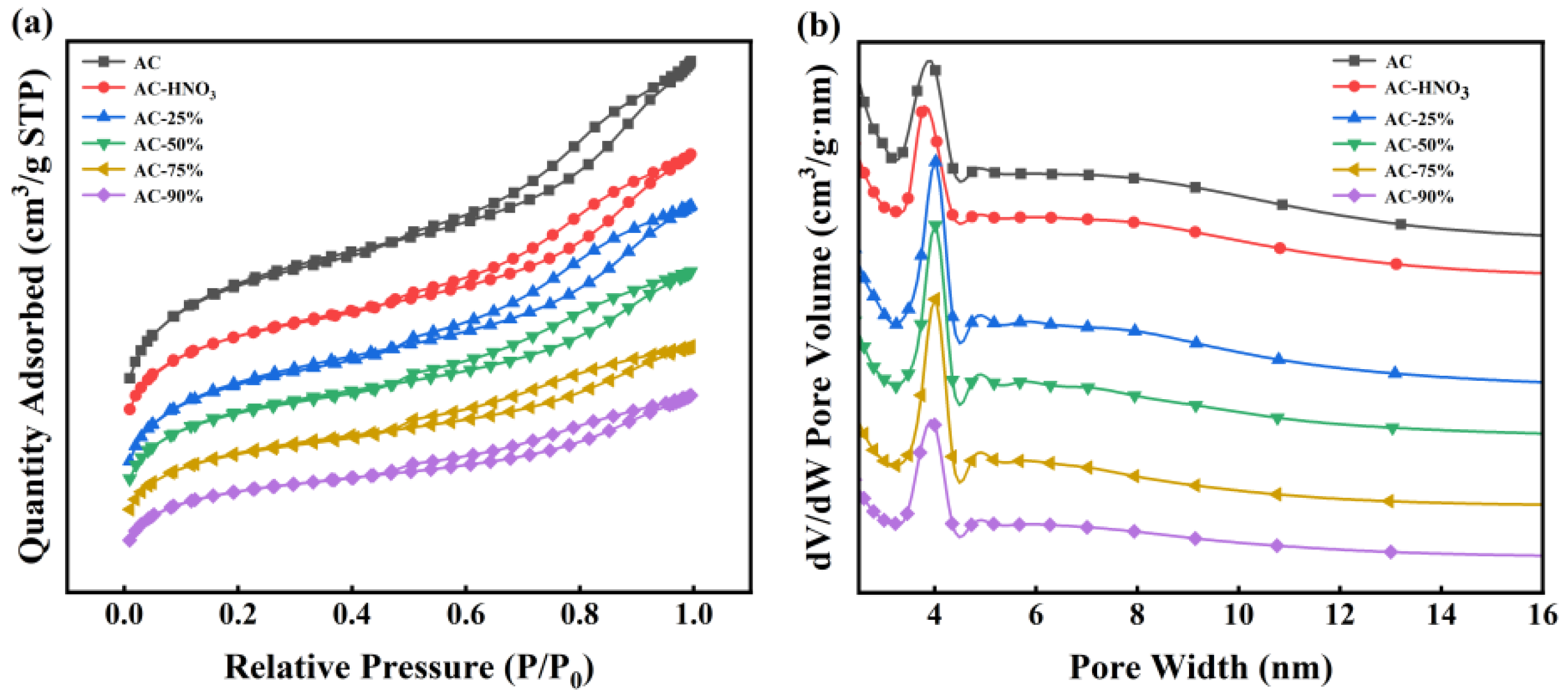

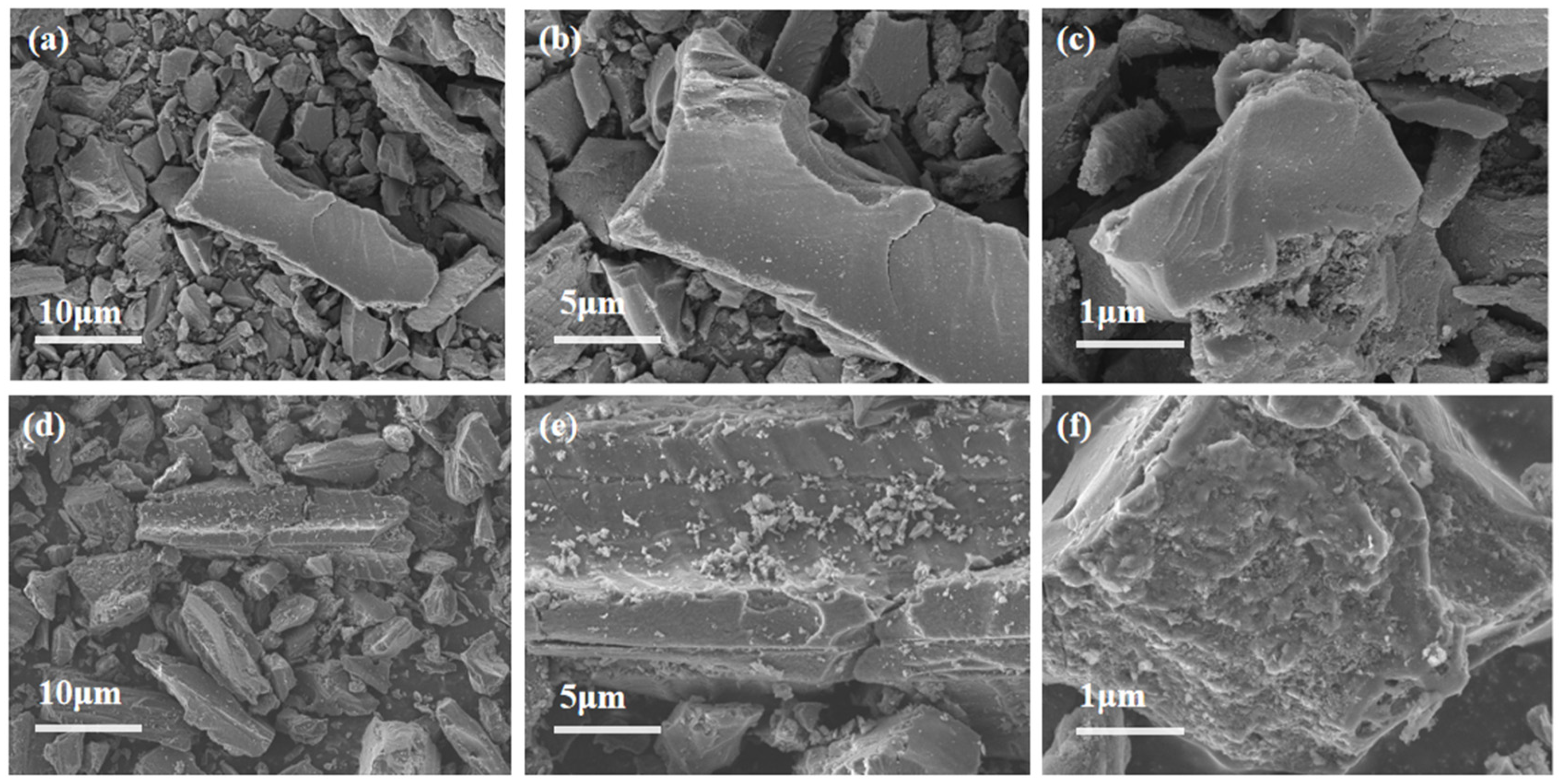
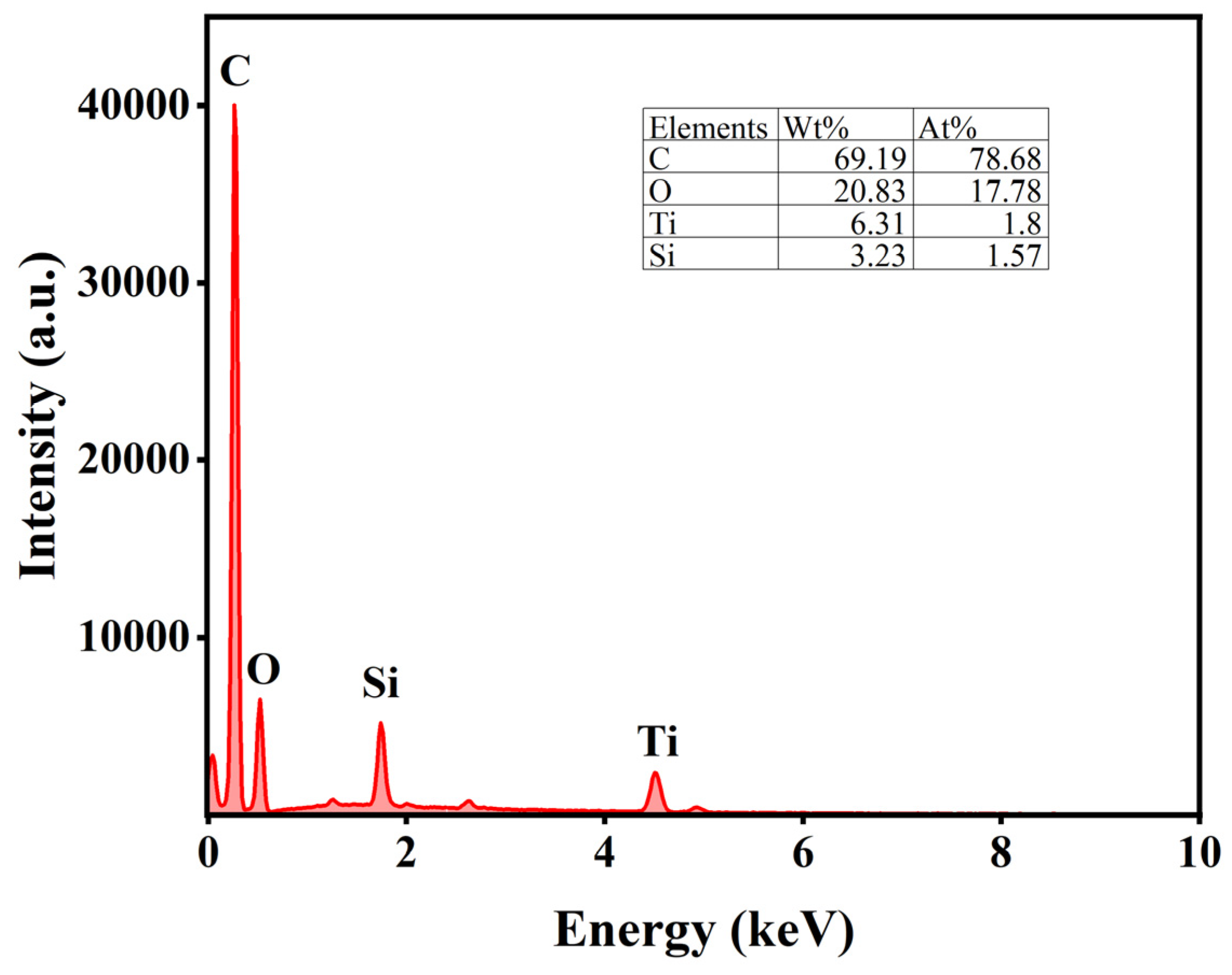
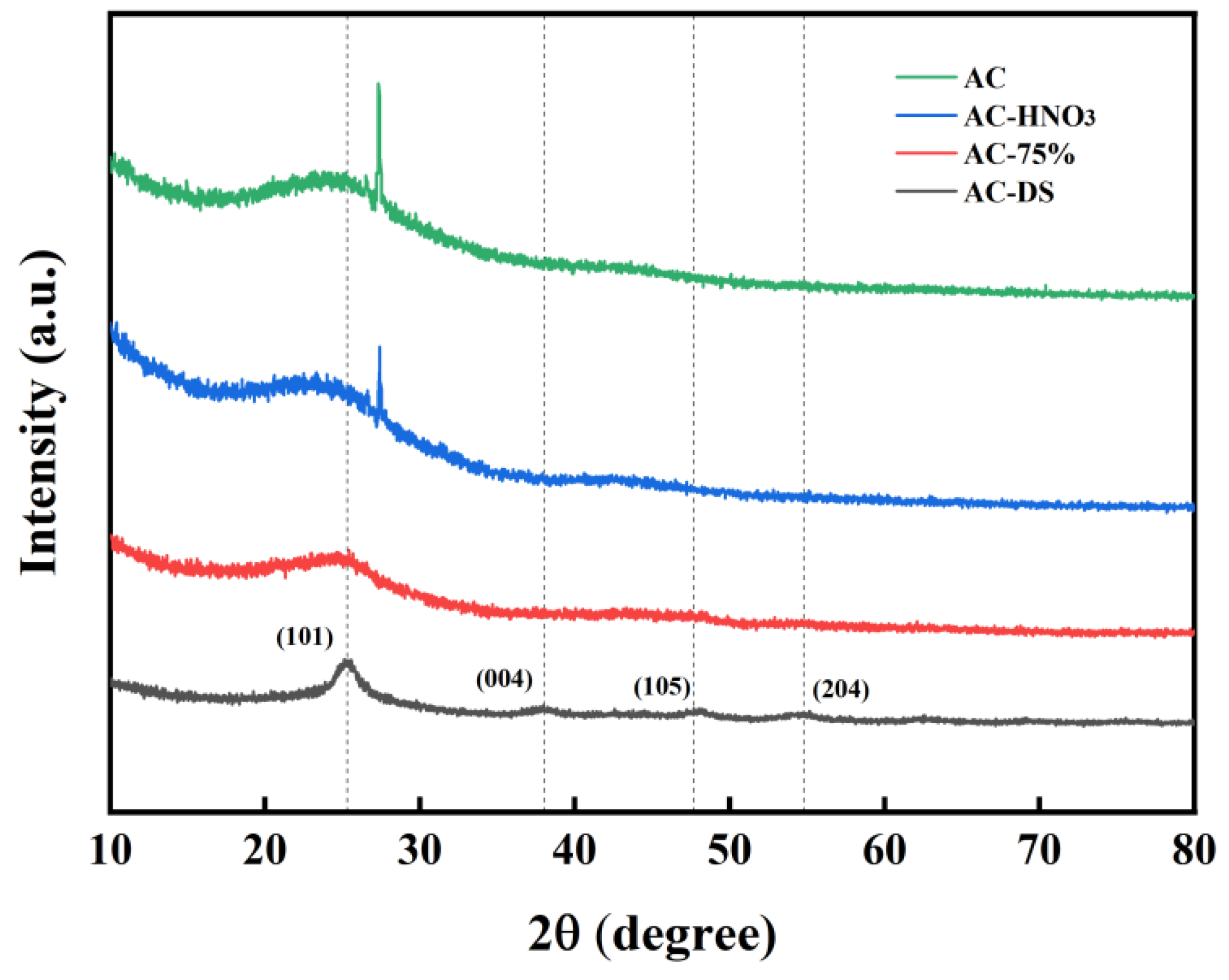
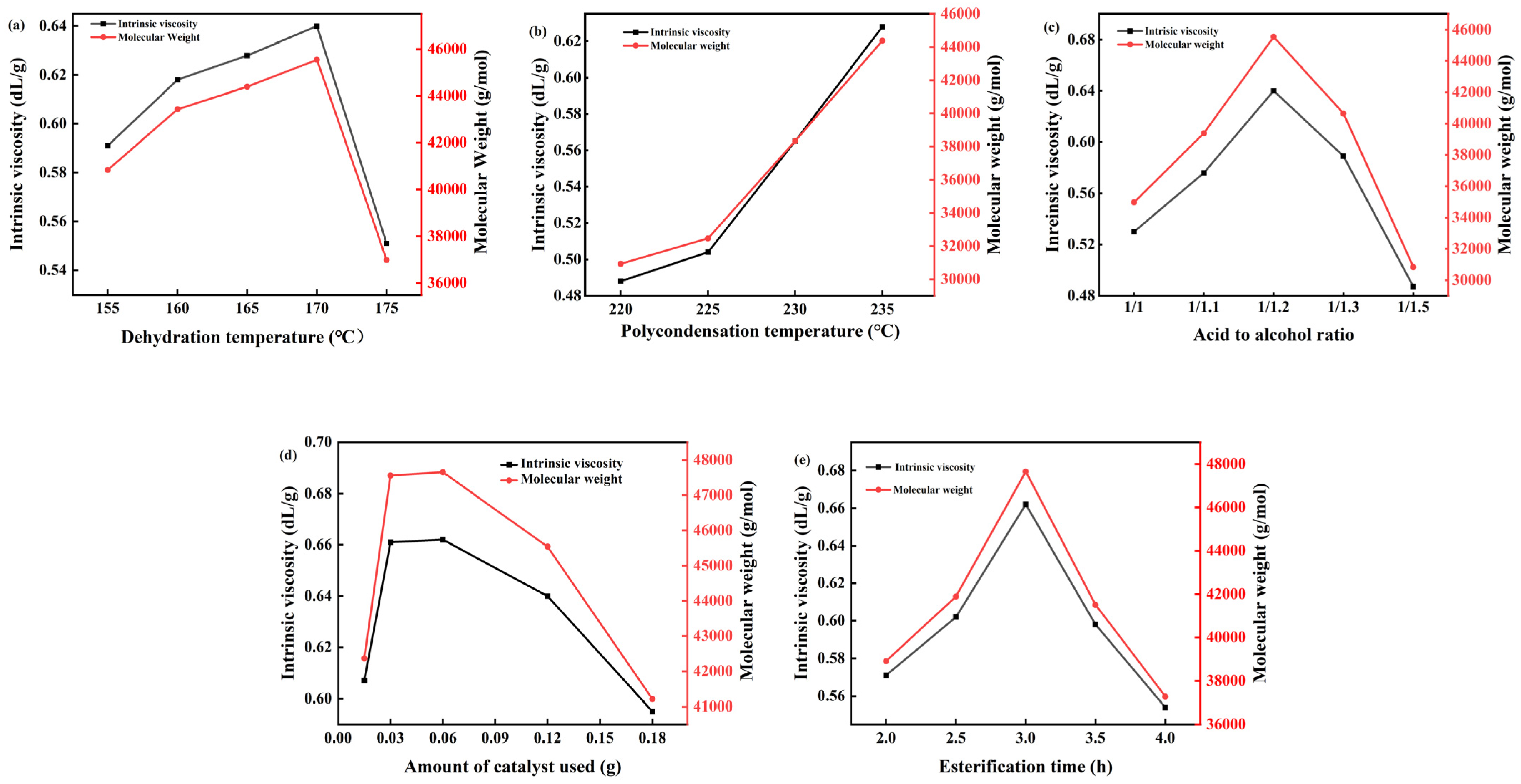
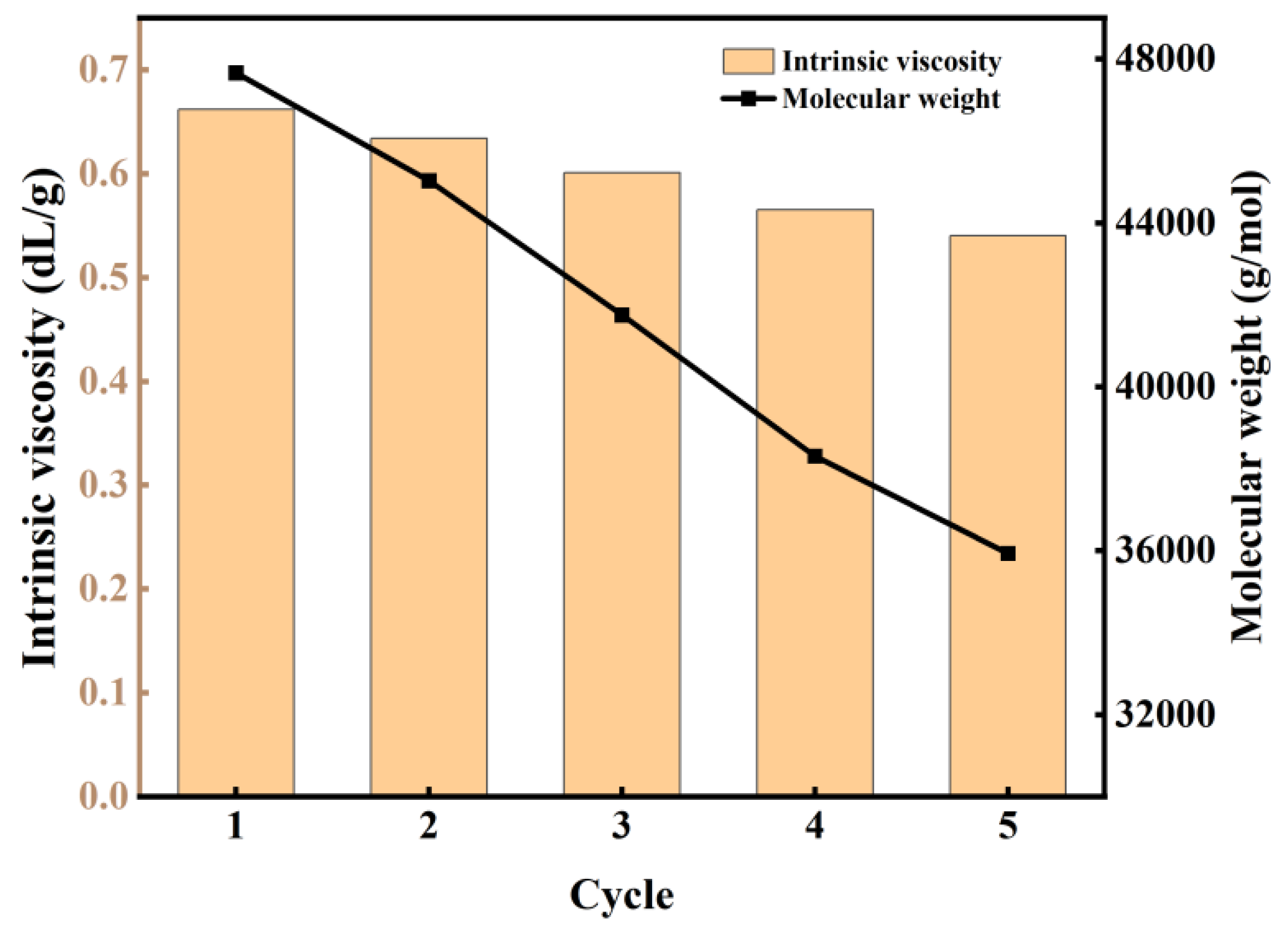
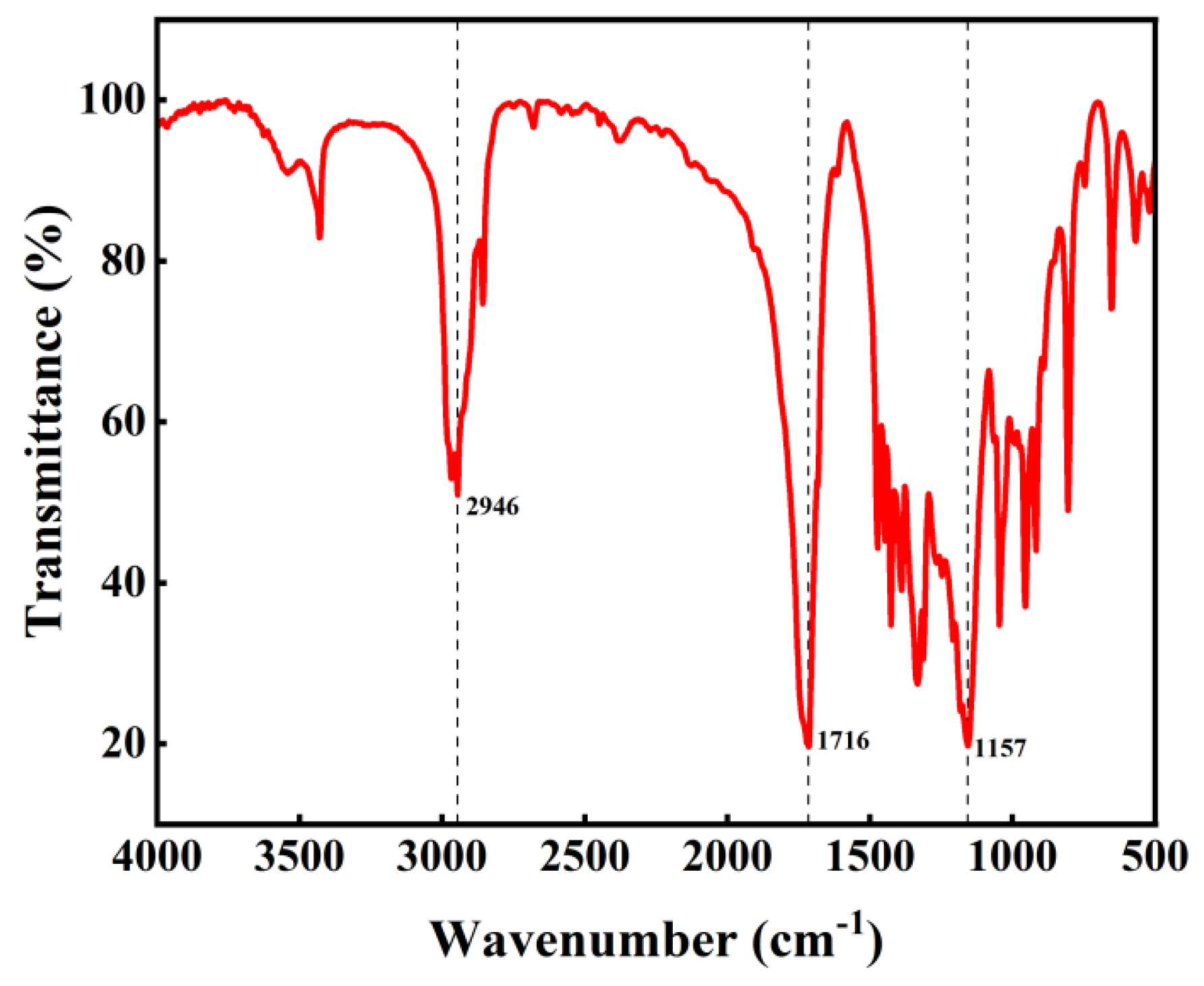

| Catalyst | Specific Surface Area (m2/g) | Pore Volume (cm3/g) | Pore Diameter (nm) |
|---|---|---|---|
| AC | 1551.9551 | 1.2772 | 4.2723 |
| AC-HNO3 | 1374.9072 | 1.1023 | 4.2541 |
| AC-25% | 1176.6737 | 0.9141 | 4.2160 |
| AC-50% | 1023.7634 | 0.8627 | 4.0830 |
| AC-75% | 1007.6578 | 0.8041 | 4.0376 |
| AC-90% | 997.9885 | 0.7443 | 3.8842 |
| Catalyst | Titanium Content | Intrinsic Viscosity (dL/g) | Mw × 10−4 (g/mol) |
|---|---|---|---|
| AC-HNO3 | 0.02% | 0.372 | 1.9778 |
| AC-25% | 3.07% | 0.461 | 2.8334 |
| AC-50% | 5.03% | 0.487 | 3.0833 |
| AC-75% | 7.18% | 0.551 | 3.6985 |
| AC-90% | 8.95% | 0.412 | 2.3624 |
| Catalyst | Catalyst Dosage (g) | Titanium Content (g) | Intrinsic Viscosity (dL/g) | Mw × 10−4 (g/mol) |
|---|---|---|---|---|
| Catalyst-free | 0 | 0 | 0.358 | 1.8432 |
| TBT | 0.03 | 0.0042 | 0.403 | 2.2758 |
| TBT | 0.06 | 0.0084 | 0.467 | 2.4681 |
| TBT | 0.09 | 0.0127 | 0.518 | 3.3813 |
| TBT | 0.12 | 0.0169 | 0.453 | 2.7564 |
| TBT | 0.15 | 0.0211 | 0.437 | 2.6026 |
| TiO2 | 0.09 | 0.0540 | 0.372 | 1.9778 |
| AC-75% | 0.09 | 0.0065 | 0.578 | 3.9580 |
| AC-DS | 0.47 | 0.0065 | 0.377 | 2.0259 |
| 0.04 gAC-HNO3 + 0.05 gTBT | 0.09 | 0.0065 | 0.412 | 2.3623 |
Disclaimer/Publisher’s Note: The statements, opinions and data contained in all publications are solely those of the individual author(s) and contributor(s) and not of MDPI and/or the editor(s). MDPI and/or the editor(s) disclaim responsibility for any injury to people or property resulting from any ideas, methods, instructions or products referred to in the content. |
© 2025 by the authors. Licensee MDPI, Basel, Switzerland. This article is an open access article distributed under the terms and conditions of the Creative Commons Attribution (CC BY) license (https://creativecommons.org/licenses/by/4.0/).
Share and Cite
Chen, M.; Zhang, G.; Wang, R. Synthesis of Poly(butylene succinate) Catalyzed by Tetrabutyl Titanate and Supported by Activated Carbon. Materials 2025, 18, 1315. https://doi.org/10.3390/ma18061315
Chen M, Zhang G, Wang R. Synthesis of Poly(butylene succinate) Catalyzed by Tetrabutyl Titanate and Supported by Activated Carbon. Materials. 2025; 18(6):1315. https://doi.org/10.3390/ma18061315
Chicago/Turabian StyleChen, Miao, Guangxu Zhang, and Ruolin Wang. 2025. "Synthesis of Poly(butylene succinate) Catalyzed by Tetrabutyl Titanate and Supported by Activated Carbon" Materials 18, no. 6: 1315. https://doi.org/10.3390/ma18061315
APA StyleChen, M., Zhang, G., & Wang, R. (2025). Synthesis of Poly(butylene succinate) Catalyzed by Tetrabutyl Titanate and Supported by Activated Carbon. Materials, 18(6), 1315. https://doi.org/10.3390/ma18061315





